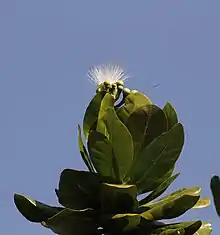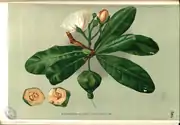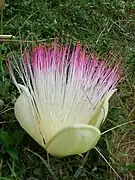Barringtonia asiatica
Barringtonia asiatica (fish poison tree,[4][5] putat[4] or sea poison tree[4]) is a species of Barringtonia native to mangrove habitats from islands of the Indian Ocean in the west to tropical Asia and islands of the western Pacific Ocean.[4][5] It is grown along streets for decorative and shade purposes in some parts of India, for instance in some towns on the southeastern shore. It is also known as Box Fruit due to the distinct box-shaped fruit it produces.[6] The local name futu is the source of the name for the Polynesian island Futuna.[7] The type specimen was collected by botanist Pehr Osbeck on a sandy beach area on the island of Java, later to be described (and given the original name of Mammea asiatica) by Carl Linnaeus in his Species Plantarum in 1753[8] (and reassigned to the genus Barringtonia by Wilhelm Kurz in 1875).[9][10]
| Barringtonia asiatica | |
|---|---|
 | |
| Flower and leaf, Bangladesh | |
| Scientific classification | |
| Kingdom: | Plantae |
| Clade: | Tracheophytes |
| Clade: | Angiosperms |
| Clade: | Eudicots |
| Clade: | Asterids |
| Order: | Ericales |
| Family: | Lecythidaceae |
| Genus: | Barringtonia |
| Species: | B. asiatica |
| Binomial name | |
| Barringtonia asiatica | |
| Synonyms[3] | |
| |
Description
It is a small to medium-sized tree growing to 7–25 m tall. The leaves are narrow obovate, 20–40 cm in length and 10–20 cm in width. Fruit produced as mentioned earlier, is otherwise aptly known as the Box Fruit, due to distinct square like diagonals jutting out from the cross section of the fruit, given its semi spherical shape form from stem altering to a subpyramidal shape at its base. The fruit measures 9–11 cm in diameter, where a thick spongy fibrous layer covers the 4–5 cm diameter seed.[4][11]
Ecology
The fruit is dispersed in the same way as a coconut – by ocean current – and is extremely water-resistant and buoyant.[12] It can survive afloat for up to fifteen years;[6] it was one of the first plants to colonise Anak Krakatau when this island first appeared after the Krakatau eruption.[4] When washed ashore, and soaked by rainwater, the seeds germinate.
Human use
All parts of the tree are poisonous, the active poisons including saponins. Box fruits are potent enough to be used as a fish poison. The seeds are ground to a powder and used to stun or kill fish for easy capture,[4] suffocating the fish while the flesh is unaffected.[13]
Gallery
 Illustration from Flora de Filipinas by Francisco Manuel Blanco
Illustration from Flora de Filipinas by Francisco Manuel Blanco.jpg.webp) Immature fruit (about fist size)
Immature fruit (about fist size) Flower
Flower
References
- Razafiniary, V. (2021). "Barringtonia asiatica". IUCN Red List of Threatened Species. 2021: e.T31339A166509744. doi:10.2305/IUCN.UK.2021-1.RLTS.T31339A166509744.en. Retrieved 19 November 2021.
- Under its treatment as Barringtonia asiatica (from its basionym Mammea asiatica L.), this species was published in Preliminary Report on the Forest and other Vegetation of Pegu App. A: 65. 1875. "Name - Barringtonia asiatica (L.) Kurz". Tropicos. Saint Louis, Missouri: Missouri Botanical Garden. Retrieved November 1, 2011.
- "Barringtonia asiatica (L.) Kurz". World Checklist of Selected Plant Families. Royal Botanic Gardens, Kew. Retrieved 23 Mar 2016 – via The Plant List. Note that this website has been superseded by World Flora Online
- Ria Tan (2001). "Sea Poison Tree". Mangrove and wetland wildlife at Sungei Buloh Nature Park. Singapore. Archived from the original on December 2, 2011. Retrieved August 23, 2016.
- "Barringtonia asiatica". Germplasm Resources Information Network. Agricultural Research Service, United States Department of Agriculture. Retrieved November 1, 2011.
- Thiel, M.; Gutow, L. (2004). The ecology of rafting in the marine environment. I. (PDF). Oceanography and Marine Biology - an Annual Review. Vol. 42. pp. 181–263. doi:10.1201/9780203507810.ch6. hdl:10533/176078. ISBN 978-0-8493-2727-8. S2CID 55427985. Archived from the original (PDF) on 2011-07-24. Accessed 2009-05-31.
- Smith, S. Percy. "Futuna, or Horne Island, and Its People". The Journal of the Polynesian Society, Vol. 1, No. 1, pp. 33 – 52. 1892
- Mammea asiatica L. (the basionym to Barringtonia asiatica) was originally described and published in Species Plantarum 1: 512–513. 1753. "Name - Mammea asiatica L." Tropicos. Saint Louis, Missouri: Missouri Botanical Garden. Retrieved November 1, 2011.
- "Barringtonia asiatica". Australian Plant Name Index, IBIS database. Centre for Plant Biodiversity Research, Australian Government.
- Kurz, W.S. (1875). Appendix A: List of Burmese forest trees. Preliminary report on the forest and other vegetation of Pegu. p. 52.
- Flora of China: Barringtonia asiatica
- Tsou, C-H., and Mori, S.A. "Seed coat anatomy and its relationship to seed dispersal in subfamily Lecythidoideae of the Lecythidaceae (The Brazil Nut Family)." Botanical Bulletin of Academia Sinica. Vol. 43, 37-56. 2002. Accessed 2009-05-31.
- Thaman, R.R. "Receptors Batiri kei Baravi: The ethnobotany of the Pacific island coastal plants Archived September 19, 2009, at the Wayback Machine." Atoll Research Bulletin. Vol. 361, 1-62. May, 1992. Accessed 2009-05-31.
